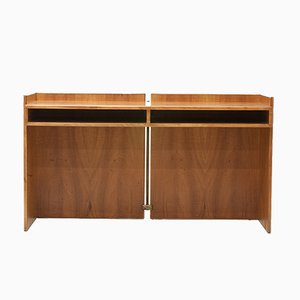
Born in Venice in 1906, Carlo Scarpa studied architectural design at the Royal Academy of Fine Arts in Venice. After graduating in 1926, he taught architectural drawing at the Academy, where he held multiple posts throughout his life. At the same time, Scarpa launched his career as an industrial and interior designer, creating multiple designs for Venini Glass Works in Venice. His most recognized pre-war project, however, was the 1935 restoration and renovation of the School of Economics at the University of Venice. His post-war commissions consisted primarily of historic building renovations, interior remodeling, and exhibition installations, often revealing the influence of Art Nouveau, Frank Lloyd Wright, and Josef Hoffmann.
Scarpa’s architecture is characterized by a great sensitivity to the changes of time. Important projects include the Canova Plaster Cast Gallery in Possagno (Treviso) (1955-1957); Olivetti showroom in Piazza S. Marco, Venice (1957-1958); and the Banca Popolare di Verona, which Scarpa began in 1973, and which was completed after his death by Arrigo Rudi.
He created multiple landscape, garden, and building designs across Italy, as well as in Canada, the U.S., Saudi Arabia, Switzerland, and France. He died in Japan in 1978. He is buried, fittingly, in the Brion Tomb complex in the San Vito d'Altivole (Treviso) cemetery—a 1969 Scarpa design that some call his most important work.

